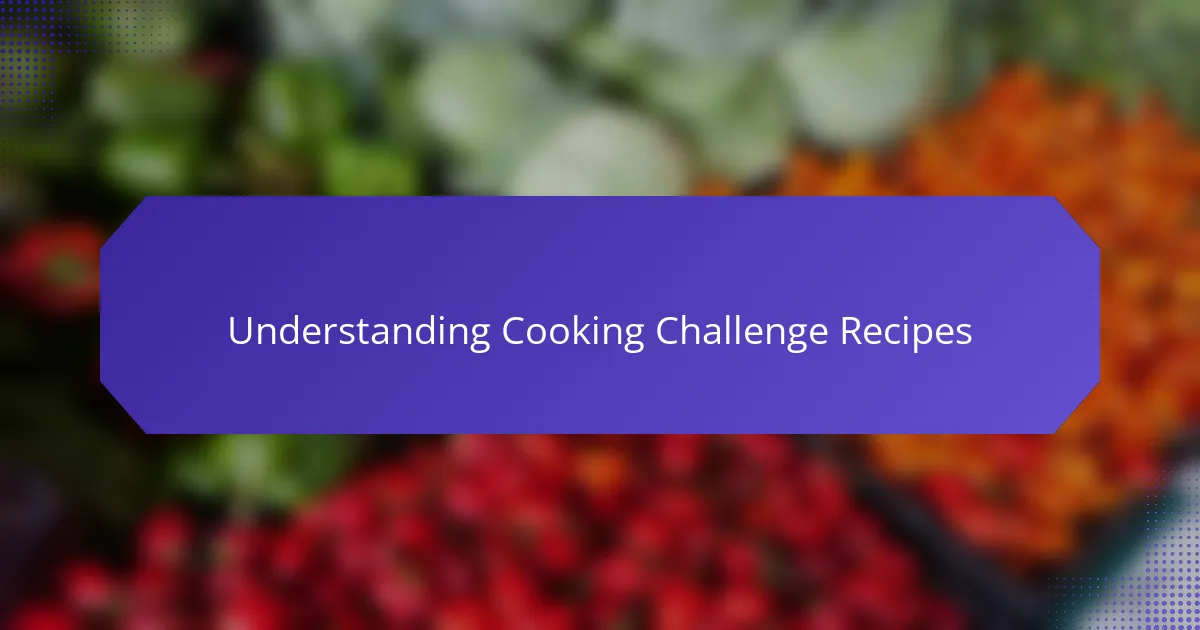Key takeaways
- Cooking challenges foster creativity and problem-solving skills, turning unexpected situations into learning opportunities.
- Mastering techniques like brining, searing, and mise en place enhances flavor and efficiency in cooking.
- Preparation and time management are essential to successfully navigating cooking challenges and reducing stress.
- Embracing mistakes during cooking leads to valuable lessons and improved culinary skills.

Understanding Cooking Challenge Recipes
Understanding Cooking Challenge Recipes can be quite the journey. Personally, I find that these recipes push you to think outside the box and elevate your skills in the kitchen. It’s not just about following instructions; it’s an exhilarating experience of improvisation and creativity, much like a culinary adventure where you’re the explorer.
I remember a cooking challenge where I had to create a dish with a surprise ingredient. The thrill of transforming that unexpected component into something delicious was both daunting and rewarding. It’s these moments that highlight the essence of cooking challenge recipes—they compel you to embrace uncertainty and turn it into opportunity.
When exploring these recipes, it’s essential to balance technique with flavor. I often evaluate recipes based on complexity and inspiration, which I’ve found helpful in structuring my approach.
| Aspect | Cooking Challenge Recipes |
|---|---|
| Technique | Emphasizes skill-building and innovative methods. |
| Ingredients | Encourages creativity with diverse or unique ingredients. |
| Outcome | Focus on personal expression and culinary growth. |
| Time | Can vary, often requiring a commitment to experimentation. |

Key Techniques from America’s Test Kitchen
When I first started experimenting with techniques from America’s Test Kitchen, I was amazed by the emphasis on precision and the science behind cooking. For example, I learned that letting meat rest after cooking ensures it retains its juices, which was a game-changer for me. I remember the first time I sliced into a perfectly rested steak; the flavor and tenderness were a revelation, and it made me realize how such small adjustments can elevate a dish.
Here are some key techniques that I often apply in my cooking:
- Brining: This technique enhances flavor and juiciness in poultry and pork. I often soak my chicken in a simple saltwater solution for a few hours, and the result is always incredibly moist.
- Searing: Starting a dish with a good sear creates a depth of flavor. I remember the first time I seared scallops; the golden crust made each bite irresistible.
- Tempering: Gradually raising the temperature of ingredients, like eggs or chocolate, prevents curdling and ensures a smooth texture. I learned this the hard way, but now my sauces are consistently silky.
- Mise en Place: This French term translates to “everything in its place.” It’s crucial for organization and efficiency—I can’t tell you how much smoother my cooking process is when I prep everything ahead.
- Deglazing: Adding liquid to a pan that’s had something cooked in it to lift the fond (the browned bits) adds richness to sauces. I love how it transforms leftover bits into something luscious.

Benefits of Cooking Challenges
Cooking challenges offer a unique way to expand your culinary skills while injecting a sense of fun into the kitchen. I remember the thrill of trying a new recipe under the pressure of a timer—what started as daunting soon transformed into a rewarding experience. Each challenge pushed me to think creatively and step beyond my comfort zone, resulting in delicious meals I never thought I could make.
One of the most significant benefits is the improvement in problem-solving skills. When faced with unexpected issues, like ingredient substitutions or equipment malfunctions, you learn to adapt on the fly. Additionally, there’s a sense of camaraderie that arises when cooking with friends or family during these challenges, which often leads to laughter and unforgettable memories.
- Enhances creativity and experimenting with new flavors
- Builds confidence in cooking abilities
- Encourages teamwork and collaboration
- Develops problem-solving skills through creative solutions
- Fosters a sense of accomplishment with completed dishes

My Initial Thoughts on Techniques
When I first delved into the techniques featured in America’s Test Kitchen, I was both excited and a bit intimidated. Their methods, while straightforward on the surface, often revealed layers of detail that transformed my approach to cooking. I vividly remember mastering the art of browning meat; the moment I noticed the depth of flavor it brought to my dishes was nothing short of exhilarating.
Here are some standout aspects that struck me:
- Precision Matters: Each technique requires careful measurement and timing. I learned that even a few minutes too long or too short can make a difference.
- Layered Flavors: I discovered the importance of building flavors step by step, which turned my simple meals into something restaurant-worthy.
- Tools and Equipment: I found that having the right kitchen tools really enhances the cooking experience. A good chef’s knife can change everything!
- Trial and Error: Embracing mistakes was part of the learning journey. I remember burning a batch of caramel but learned so much from that mishap.
- Confidence Boost: Each technique I mastered built my confidence in the kitchen. It felt empowering to tackle more complex recipes after getting the basics down.

Experiences with Specific Recipes
One of my favorite experiences with a specific recipe from America’s Test Kitchen was their creamy risotto. I remember the first time I took my time, stirring and adding broth gradually. The way the rice absorbed the liquid and transformed into a velvety texture was mesmerizing. It taught me the importance of patience in cooking—something I sometimes struggle with. But once I got it right, each spoonful was a comforting reminder of why I love cooking.
Another unforgettable recipe was the homemade pizza tutorial. The dough-making process felt daunting at first, but I found it incredibly satisfying to knead the dough until it was perfectly smooth. I vividly recall my sense of accomplishment as I pulled my first pizza out of the oven, the aroma filling my kitchen. The combination of a crispy crust and fresh toppings made each slice a celebration of all that effort. Who knew that just flour, water, and a bit of love could create such joy?
Then there was the challenge of mastering a classic French onion soup. The technique of caramelizing the onions slowly opened my eyes to the magic of cooking. I can still picture the moment when I added the broth and watched the flavors meld together. It was during this recipe that I truly appreciated the time commitment in cooking. The result was not just a dish, but a warm embrace on a chilly day—definitely worth the wait!

Tips for Successful Cooking Challenges
When it comes to cooking challenges, preparation is key. I’ve found that organizing your workspace and ingredients makes a world of difference. It helps reduce stress while cooking, letting me focus on honing my techniques and enjoying the process.
Time management is crucial too. I remember the first challenge I attempted; I underestimated how long certain techniques would take and ended up rushing through crucial steps. Now, I always set a timer for each phase, allowing me to stay on track without feeling overwhelmed.
Lastly, don’t be afraid to make mistakes. Each misstep is a learning opportunity. I’ve had my share of culinary flops, and looking back, they taught me invaluable lessons about flavor combinations and cooking times. Embracing the journey has made me a better cook.
| Tip | Description |
|---|---|
| Preparation | Organize your workspace and ingredients before you start cooking. |
| Time Management | Set timers for each cooking phase to avoid rushing and mistakes. |
| Embrace Mistakes | View missteps as learning opportunities rather than failures. |


